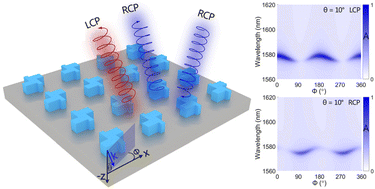Photonic spin-selective perfect absorptance on planar metasurfaces driven by chiral quasi-bound states in the continuum
Abstract
Optical metasurfaces with high-quality-factor resonances and selective chirality simultaneously are desired for nanophotonics. Here, an all-dielectric planar chiral metasurface is theoretically proposed and numerically proved to support the astonishing symmetry-protected bound state in the continuum (BIC), due to the preserved π rotational symmetry around the z axis and up-down mirror symmetry simultaneously. Importantly, such BIC is a vortex polarization singularity enclosed by elliptical eigenstate polarizations with non-vanishing helicity, owing to the broken in-plane mirror symmetry. Under the oblique incidence, companied by the BIC transforming into a quasi-BIC (Q-BIC), the strong extrinsic chirality manifests. Assisted by the single-port critical coupling, the planar metasurface can selectively and near-perfectly absorb one circularly polarized light but non-resonantly reflect its counterparts. The circular dichroism (CD) approaching 0.812 is achieved. Intriguingly, the sign of CD (namely, the handedness of the chiral metasurface) can be flexibly manipulated only via varying the azimuthal angle of incident light, due to the periodic helicity sign flip in eigen polarizations around the BIC. Numerical results are consistent with the coupled-mode theory and multipole decomposition method. The spin-selective metasurface absorber empowered by the physics of chiral Q-BICs undoubtedly may promise various applications such as optical filters, polarization detectors, and chiral imaging.

- This article is part of the themed collections: Nanoscale Most Popular 2023 Articles and 2024 Lunar New Year Collection


 Please wait while we load your content...
Please wait while we load your content...